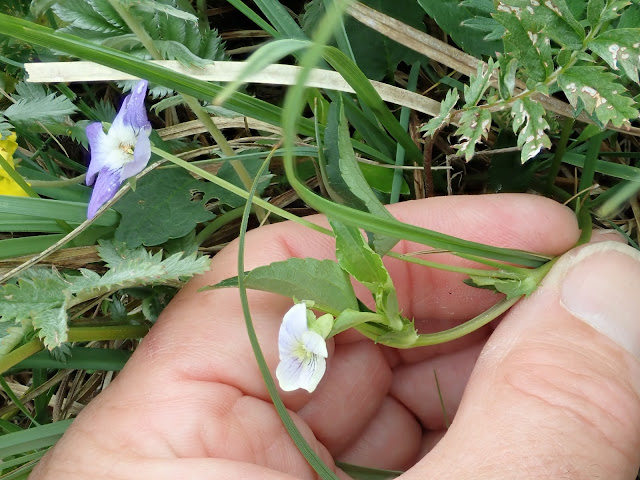Fen Violet ( Viola stagnina ) or a hybrid?.
This was one species of Violet that I had never seen. The local population in Wicken Fen has not been seen for many years and it would appear to have gone from Woodwalton Fen. A trip to the Burren in May 2018 had failed to definitely find one, although a possible hybrid with Heath Dog Violet ( V. canina) was seen in a grike.
 |
| The Burren, below Mullagh More. May 2018 |
That potential Fen Violet looked good in terms of flower colour, but didn't quite in other details.
 |
| Potential Fen Violet May 2018 |
Another chance to see Fen Violet occurred in June 2025, when I was able to visit Mullagh More and its adjacent turloughs again. An even better candidate was found, however it would seem that Fen Violet at this site has largely hybridised with the more common Heath Dog Violet. This hybrid is called Viola x ritschliana. A search south west of the road near the start of the walk to Mullagh More in a turlough, which had previous records, produced zero violets, which was disappointing. Despite the dry weather there was still water in the turlough and the edges looked like suitable habitat.
It was during a lunch break that our luck changed and a small population of about six violets was found near the turlough below Mullagh More. R 3107 9456
 |
| Flower Plant 1 , 28th May 2025. |
The flowers of Fen Violet are supposedly flat but the backward upper petals on this example do not conform to that description. The tinge of violet on the petals is perhaps slightly more than typical for Fen Violet?
 |
| Spur and sepal appendages. Plant 1. |
Fen Violet is supposed to have a short straight pale green spur, whereas V. canina typically has a trace of pale yellow. The hybrid apparently has slightly longer whitish spurs which may be decurved. This spur looks good for Fen Violet. The backward pointing sepal appendages are very big but so are those on V. canina. In fact I find that the big sepal appendages are a really good feature in V. canina when separating from other Dog Violets.
 |
| Stipules. Plant 1. |
 |
| Leaf Shape Plant 1. |
 |
| Leaf Shape Plant 1. |
 |
| Not far (2m) from Plant 1 was another group of violets. |
 |
| Two colour flowers on same stem. |
This phenomenon is common in Roses. Wild roses are all derived from hybrids thanks to reticulate evolution* and often 'species' that have been stable, have consistent features, whereas if you find a rose bush with different features on different stems it is often a more recent hybrid. This might be chimerism, a term I was not familiar with in plants. It would appear that chimera are not fully understood and quite what would explain these two different flowers on the same stem remains a puzzle.
"In plant biology, chimera is often used to denote a specific case of visible variegation called Genetic mosaicism, which is a phenomena where cells of different genetic load are present within the tissue of one plant. "
Conclusion.
The fact that all the violets were in a small group with different coloured flowers would point to all of them being hybrids. To claim a Fen Violet I think I would have to find a population of consistent plants with very pale flowers and thin leaves. It would appear that the Fen Violets around Mullagh More have been hybridised out by the V. canina and another turlough in the Burren might be a better place to search.
 |
| Plant 2. Pale flower on stem with blue flower. |
 |
| Plant 2. Blue flower on stem with pale flower. |
Life is never simple.
Peter Leonard 24th June 2025
Ref BSBI Handbook No 17 Violas of Britain and Ireland. 2017 by Michael Porter and Micheal Foley.
A paper on Chimerism in plants can be found :-